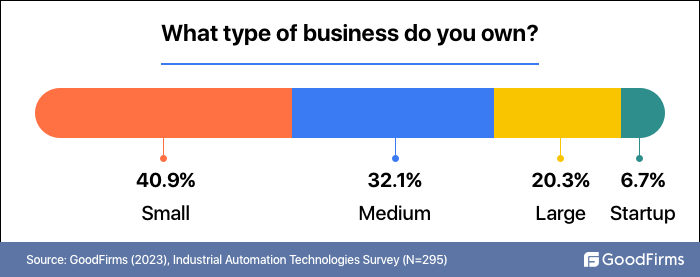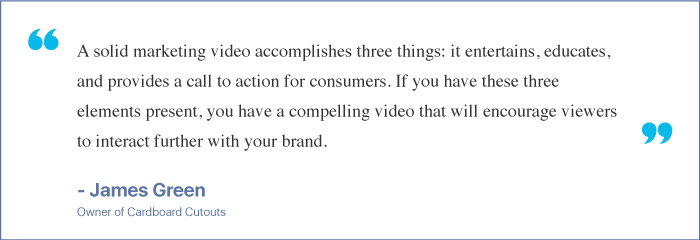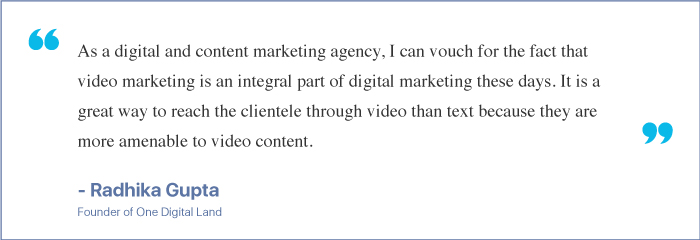ABSTRACT:
Videos connect better with the audiences. Interestingly, consumers continue to choose video over other types of content, and videos are surpassing all other content forms when it comes to the ‘engagement’ criterion. Major social media platforms prioritize video content. Even new gadgets like smartphones and tablets are more video-ready than ever. Video marketing is undoubtedly becoming a quintessential strategy for businesses. With the help of video marketing, companies can effectively engage their target audience as part of their marketing initiatives.
The GoodFirms research titled: ‘Video Marketing - Usage, Market, Scope, and the Future’ is an attempt to provide companies, e-commerce businesses, and local businesses with valuable insights regarding the current video marketing trends, shifts, scope, and future outlook. The survey will also reveal consumers’ perception of videos over other content forms. The research will help companies rebalance their current strategies, meet consumer demands, and scale their businesses.
Table of Contents:
Introduction
Growing Usage of Video Content in Marketing
Survey and Data Analysis
Introduction
96% of marketers agree that videos have helped increase user understanding of their product or service, and 87% of marketers feel that video directly impacts sales.(1)
The strategy of using videos to advertise goods, services, or brands is known as video marketing. The increasing popularity of social media channels like YouTube, Instagram, Facebook, and TikTok has made videos easily shareable and viewable. Brands are now using video marketing to introduce their goods/services, create brand recognition and build relationships with their customers.
Product demo videos, GIFs, tutorial videos, explainer videos, webinars, and promotional videos are a few types of videos used for content marketing. With the technology advancements, businesses also have the accessibility to video creation tools and software to produce and distribute video content. In the future, the usage of AR/VR and AI will help to improve both the brand's and customer's experiences with video marketing.
‘Video Marketing - Usage, Market, Scope, and the Future’ is a survey conducted by GoodFirms that attempts to identify and analyze the current state of video marketing, its key driving factors, opportunities, challenges, the most preferred social media platforms, and future scope in the video marketing strategy. The survey also elaborates on determining the elements impacting consumer preference shifting from text content to video content, the role of social media channels, and the technologies that make the future of video marketing successful.
Growing Usage of Video Content in Marketing
Businesses are employing more and more videos to interact with their customers with the availability of fast network connectivity. As technology becomes more widely available and more affordable, this adoption rate is likely to rise in the future.
According to the GoodFirms survey, 73.9% of marketers are using video as a crucial component of their sales and marketing strategy.

Statistics for global video marketing are as follows:
- The audience reach of online videos among all internet users globally was over 93%.(2)
- In 2022, video accounted for 82% of all internet traffic worldwide.(3)
- 86% of marketers believe that videos increased their website traffic.(4)
- 14.9% of Millennials watch 10.9 to 20 hours of online video each week.(5)
- In the United States, spending on video advertising was projected to reach $78.5 billion in 2023.(6)
Following are the benefits of video marketing to businesses:
- Videos help in increasing audience engagement time on social media.
- It helps in gaining more exposure and audience engagement.
- Improve consumer awareness of products/services.
- It helps in showcasing the uniqueness of the brand.
- Give the audience a more personalized way to interact with companies.
- Videos are effective sales tools.
- Helps in increasing search ranking.
- Videos are becoming popular across all social media platforms.
SURVEY AND DATA ANALYSIS
GoodFirms surveyed 920 companies worldwide to analyze how they are using ‘videos’ to inform audiences and promote their product or services. The survey revealed valuable insights into the current usage of video content by business owners. From increasing engagement on their digital and social media platforms to improving user time on websites, businesses are using videos for various purposes.
Our research uncovers interesting insights regarding the current state of video marketing in the advertising industry, objectives of video marketing, its key types, elements, and future.
Let us analyze the key survey findings:
Top Objectives of an Effective Video Marketing Strategy
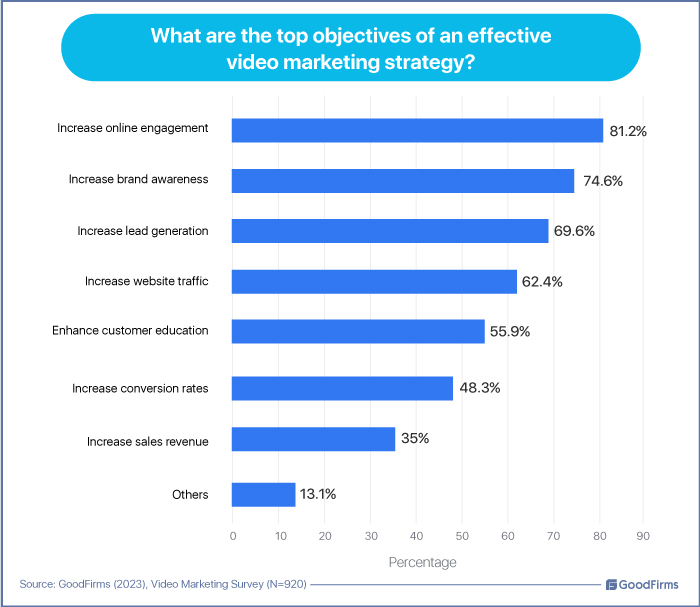
Increase online engagement
81.2% of the surveyed marketers say increasing online engagement with the audience is the topmost objective of video marketing strategy
People have a tendency to remember a video story more than a list of facts presented in the form of a document. Videos provide advertisers the opportunity to produce their message into a concise narrative that captivates their audience in a way that text cannot.
For example, Airbnb is pro at making promotional videos that engage viewers with its brand and at fostering relationships between hosts and tenants. The Airbnb team told a captivating story in the video that vividly depicts all the wonderful moments of an Airbnb journey.(7)
Moreover, videos are easy to consume than text, which requires more effort from the audience. Videos are also easy to share on blogs, social media channels, and other websites. Businesses expand their reach and audience engagement by producing shareable video content.
Increase brand awareness
74.6% of the surveyed respondents believe increasing their brand awareness is the top objective of effective video marketing
It's important to have a successful brand awareness video strategy if brands want to increase their recognition and foster consumer trust. Customers find videos appealing, which also raises the chances of buying.
Nike, for example, has consistently made significant investments in video-based brand awareness campaigns (Just Do It) and films (Moving Mountains) that showcase its underlying principles as a business and in its interactions with customers.(8)
Increase lead generation
69.6% of the surveyees think increasing lead generation is a prime objective of an effective video marketing strategy
Video marketing generates a higher level of viewer engagement since viewers are more likely to watch a video than read text. Engagement is essential for marketing. A larger probability of converting the audience into leads is possible by using videos; this way, brands can keep them interested. For example, Toyota discovered a special approach to telling its brand story by showcasing all of its well-known vehicles in a stunningly original visual manner.(9)
Increase website traffic
62.4% of the surveyed participants say video marketing’s objective is to increase traffic on business websites.
Video is great for SEO because it keeps users on the company's site longer. The longer a visitor spends on a page is a significant element in page ranking in search results. For example, the marketing video of Coca-Cola shows that Coca-Cola is more than just a drink. It’s the drink for everyone; it’s a brand that unifies all the people in the world.(10)
Enhance customer education
55.9% of the surveyed companies consider educating the audience as an important objective of video marketing
Customer training programs involve educating customers about the benefits of a product or service through videos so they can get the most out of it. For example, Oral-B demonstrates to viewers how to use their electric toothbrushes for the best results by using short demo videos.(11)
Increase conversion rates
48.3% of the surveyed marketers say that the video marketing strategy’s objective is to increase conversion rates.
Videos are becoming one of the most effective components of digital marketing. A landing page with a video can increase conversions. By involving the audience, delivering useful information, showcasing the brand's product or service, fostering a sense of trust, and boosting social proof, videos are a powerful tool for increasing conversion rates.
For example, Starbucks coffee beans are depicted in the video, showing how they are cultivated, sourced, roasted, and then prepared for consumption. This video strategy is able to increase brand passion and provide education and exposure to the brand while maintaining entertainment value.(12)
Increase sales revenue
35% of the surveyed organizations consider increasing sales revenue as the main objective of an effective video marketing strategy.
94% of people have watched an explainer video in order to learn more about a product or service.(13) Videos are known to boost sales by providing quick and easy-to-understand information on the brand’s products and services and even corporate culture. Sometimes, people are inclined to buy products and services from companies with great corporate culture. For example, the video by Hubspot demonstrates its creative approach to corporate culture. To demonstrate that their team consists of experts who are enthusiastic about their work, they used the right amount of humor in the video and made an effort to include every team.(14)
Other
13.1% of the surveyed video marketers have mentioned other objectives, such as keeping up with current trends, gaining customers’ trust, and improving customer experiences.
Types of Video Content
Many businesses produce video material such as corporate videos, customer onboarding videos, customer service videos, interactive videos, live-action videos, teaser videos, training videos, and many more as a component of their marketing plans in order to engage their audiences and attract new customers.
Creating video content is a powerful approach to interacting and connecting with potential customers while educating them about the brand's goods and services. Marketers will continue using video as a part of their marketing strategy as it helps companies to enhance customer connections and gain trust that allows their customers to know them better. Here is the survey result of GoodFirms, where the company tried to gather insight into the most commonly used type of video content.
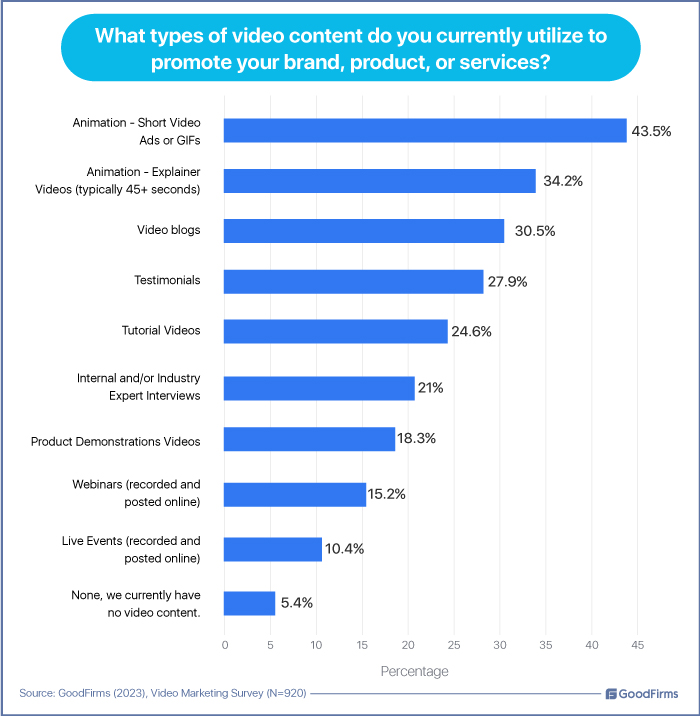
Animation - Short Video Ads or GIFs
43.5% of the surveyed video marketers prefer short video ads or GIFS to promote their brand and its goods/services.
Companies use short video ads or GIFS for their emails, websites, or blogs to stand out from the competition and improve their visual marketing results. GIFs draw more attention and help in increasing customer engagement (views, shares, and clicks) on all types of marketing platforms.
Animation - Explainer Videos (typically 45+ seconds)
34.2% of the survey respondents use explainer videos to achieve their business goals and sales objectives.
A short-form video that highlights a company's product, service, or business idea in an effective and appealing way is known as an explainer video. These videos are typically used for marketing or sales objectives. Explainer videos assist businesses in combining text, audio, and visual information to facilitate customer education, raise brand awareness, establish credibility, and encourage customer involvement.
Video blogs (Vlogging)
30.5% of the survey participants create video blogs as a part of their sales marketing strategy.
Vlogging (video blogging) helps companies to increase their social media presence and brand exposure. As more consumers demand personalized engagement, vlogging is becoming more and more popular and helping brands in gaining more views on their marketing videos daily. 32% of adults between the ages of 18 and 34 reported watching three or more vlogs weekly.(15) Video blogs assist companies in sharing information with vlogs in a unique and personalized way.
Testimonials
27.9% of the surveyees use testimonial videos to introduce their brand’s products and services.
Customers get an opportunity to share their stories and experiences in testimonial videos. Potential customers can view the original reviews of a product or service by watching testimonial videos on the company's website or social media channels. This increases their trust in the company and its goods/services.
Tutorial Videos
24.6% of Marketers use tutorial videos as a part of their content marketing strategy
Companies use product/service tutorial videos to demonstrate how to use their products or services. The main objective of the tutorial video is to show both present and potential customers the value of the goods that companies are selling to them.
Internal and/or Industry Expert Interviews
21% of the surveyed companies post industry expert interview videos on their website to promote their products.
Expert interview videos, like the CEO interview, are an excellent method for marketing purposes as the audience can hear from experts directly regarding the industry. This way, the audience can gain knowledge, and the company can build strong credibility.
18.3% of the surveyed video marketers use demo videos to promote their brand, product, or services and boost sales. Whereas 15.2% and 10.4% of the survey participants use webinars and live event videos, respectively, in order to create brand awareness and for promoting their goods/services.
GoodFirms, in its survey, tried to gather insights on the purpose of creating marketing videos. Here is the result for the same;
The Purpose of Creating Marketing Videos
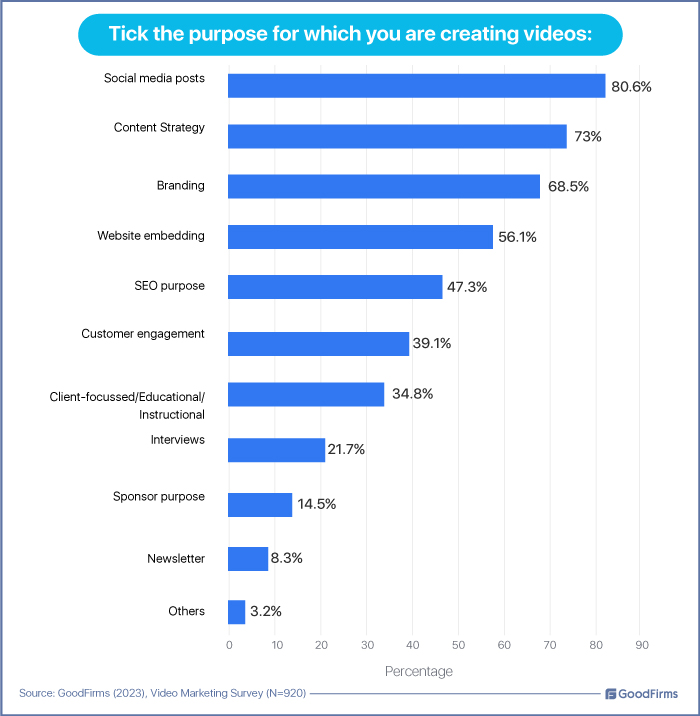
“Create videos with a distinct purpose. Anticipate your ideal consumer’s needs and create content to address those needs.” - Brian Rotsztein, Internet marketing pioneer and SEO expert
Social media posts
80.6% of the surveyed video marketers create marketing videos to post on social media channels.
Organizations of all types prefer promoting their goods or services on social media to gain wide audience attention. An effective marketing video helps to engage and educate social media customers. Brands create marketing videos to post on their social media channels to promote products or services and to generate or escalate brand awareness to a larger audience at the same time.
“Following current social media trends can actually help your brand establish a presence on social media platforms like TikTok & Instagram. You can achieve this by producing and sharing videos that are relevant to these popular platforms,” says David Cohen, the CEO of Flower Station.
Content strategy
73% of the surveyed participants prepare marketing videos for the purpose of content strategy.
A video content strategy is a plan that uses visuals to promote the brand’s material and accomplish its business objectives. Businesses aim at creating appealing videos to improve their content strategy that will help brands to rank high on google and increase their conversion rates.
Branding
68.5% of the surveyees said the creation of marketing videos is done for branding purposes.
People watch videos to learn more about different goods and services. Branding videos are produced as a part of a wider marketing effort to highlight the company's goals, objectives, or goods and services. Building brand recognition for the business as well as captivating and attracting the target audience, are the objectives of branding videos.
Website embedding
56.1% of the surveyed respondents create marketing videos that can embed with their website.
Brands use an excellent technique to engage more website users and strengthen the appeal of their content by including marketing videos on their business website or page.
SEO purpose
47.3% of the surveyed companies create marketing videos to gain ranking and traffic generation on their sites.
Video results are 50x more likely to be ranked in Google than text-based results.(16) Brands focus on creating videos that viewers generally prefer searching for. These videos are optimized for search engine ranking in order to rank well in search results.
Customer engagement
39.1% of the surveyed video marketers create marketing videos to increase audience engagement with the brands and their products/services.
Businesses use videos as a medium to communicate with potential customers, who can be turned into leads. Businesses build strong customer relationships by using entertaining and educational video content to raise brand awareness and sales. Effective customer engagement thereby promotes sales funnel velocity, improves customer experience, and increases brand loyalty.
Client-focussed/Educational/Instructional
34.8% of the surveyees said that they create videos to educate/instruct their customers about the brand’s products or services.
The perfect fusion of entertainment and knowledge is educational videos. 53% of people have a more favorable opinion of businesses whose websites or apps have instructional video content.(17) Therefore, brands use educational marketing videos to inform the audience about the business, products, or services.
21.7% of the surveyees said the creation of marketing videos is done for interview purposes, and 14.5% of the surveyed respondents consider creating marketing videos for sponsor purposes. 8.3% of the surveyed companies create marketing videos for their newsletters.
Key Elements of a Successful Video Creation
“To make a successful video, you need to define the video's length, script, content, format, sound, lighting, editing, and captions according to your business. In the video, you should always remind your audience why they should keep watching your video. After your video is complete, it's important to distribute it to your audience through the right channels. Your business intro video should be on the main page of your website. You can distribute it through the PPC ads and Youtube. Video marketing can explain your business services more easily to your customers”, says Nikhil Kumar, Founder of Technical Nick
GoodFirms tried to gather information on the top key elements to make a successful video. Here is the survey result for the same;
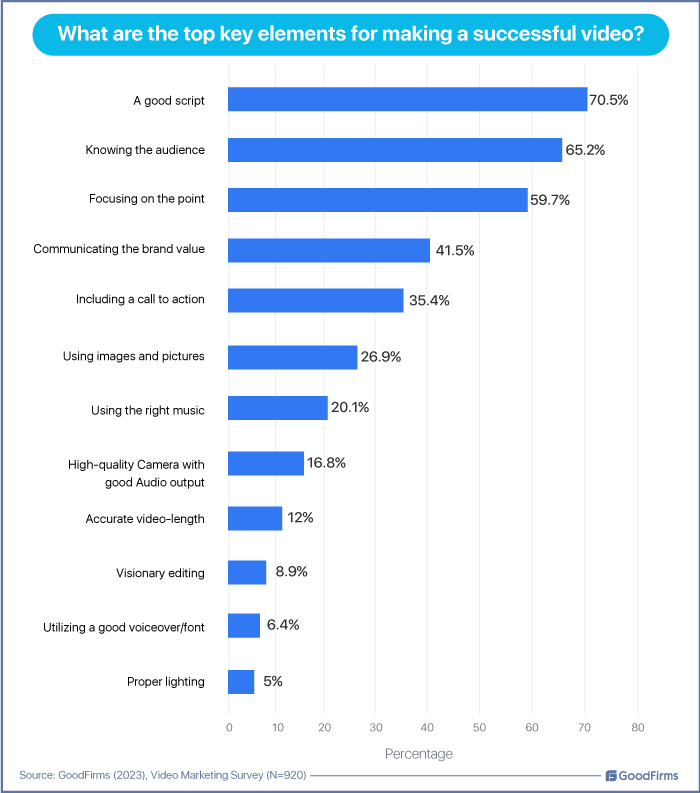
A good script
70.5% of the surveyed participants suggest a good video script as a key element for a successful marketing video.
An effective video script is conversational, real, and direct. A video script provides a blueprint for the main objective of the video's plot. At the end of the video, marketers want viewers to make a decision to buy their product or service. Therefore, as per the survey result, a good script that is clear, engaging, and has an interesting storyline stands as the top-most factor for a video.
Knowing the audience
65.2% of the surveyees said understanding the target audience stands as the prime element to creating a successful video
“The most successful videos incorporate your target audiences' story. That story needs to be built on viewers' likes, dislikes, goals, challenges, and achievements”, says Joe Pope, business development expert and partner at Hinge.
Companies must focus on creating video content that can effectively convey their message to the target audience, which enables them to establish relationships with customers that will boost their conversion and retention rates. Without knowing the target audience, writing and releasing any content will have a low impact. There is very little likelihood of reaching the target market, and as a result, very little probability of achieving the SMART goals of the company.
Purpose-built video
59.7% of the surveyed video marketers prefer focusing on the message as a key element that video must convey to the viewers.
Delivering the message of the video to the customers is one of the important factors to be considered while developing a video. Whether the video aims at introducing a product or service or is an educational video, the audience must find it appealing. It must effectively convey the message. In order to accomplish the business objectives of lead conversion from the video, it must be interesting.
Communicating the brand value
41.5% of the survey respondents consider the communication of the brand value as an essential variable to be considered while developing a marketing video.
Another main purpose of a good marketing video is to communicate the brand value and create brand awareness among the audience all over the channels.
Including a call to action
35.4% of the surveyees said including a CTA in the video is an important component to be kept in mind while creating videos.
The most crucial component of any content is including the CTA or call to action. Its strength or weakness determines if the marketing content as a whole is successful in achieving its objectives because it is the aspect that motivates viewers to take action.
Using appealing graphics and audio
26.9% of the surveyed companies prefer using appealing graphics in their marketing videos to make them more appealing to the audience. And 20.1% of the surveyed participants believe that choosing the right audio can also add value to the brand’s marketing videos.
Including graphics and audio in a sales marketing video make it more engaging, attractive, and appealing to the viewers. As a result, customers stay engaged and watch the video to the end, which can lead to a high conversion rate.
High-quality camera with good audio output
16.8% of the surveyees said a high-quality camera with good audio output is one of the important variables of creating a great video.
Choosing a high-quality camera with a good audio output in creating sales videos can result in high retention and engagement of the customers.
12% of the surveyed video marketers consider that accurate video length affects a marketing video's quality. And 8.9% of surveyees said visionary editing is required to produce appealing marketing videos. Whereas 6.4% and 5% of the surveyed companies said utilizing a good voiceover/font and proper lighting are also required to make the marketing video effective and attractive to the viewers, respectively.
Video Marketing Technology
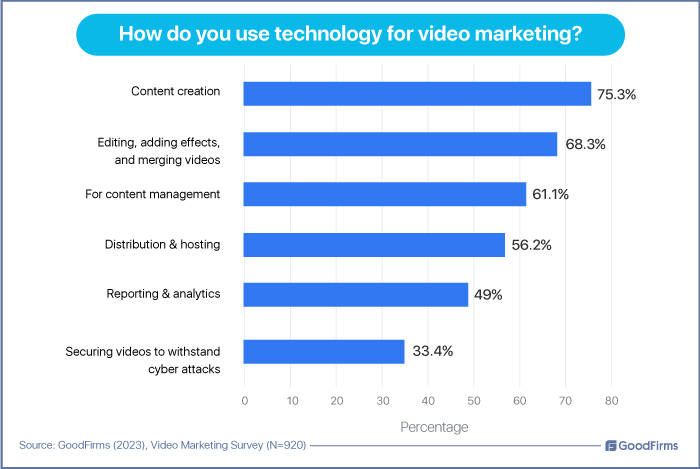
Content creation
75.3% of the surveyed video marketers use technology to create content for marketing videos.
Software for editing videos, animation software and AR/VR helps advertisers and marketers in producing high-quality video content quickly and at a low cost. GoodFirms surveyees also indicated that they are deploying AI video creation tools to create more personalized video content for their audiences. Personalized videos can go a long way in building an unbreakable bond between brands and customers.
“Imagine watching and enjoying one unique video made specifically for you. The future of making personalized videos for individual viewers on a large scale may be a reality with the help of AI. AI can evaluate viewer data and generate videos based on an individual's interests and preferences. This could be especially valuable in marketing and advertising, as personalized content can reach and engage people more effectively”, says Nicky Dutta, CEO at Lorel Diamonds
Editing, adding effects, and merging videos
68.3% of the surveyed participants use video editing, adding effects, and merging software while creating their marketing videos.
Companies prefer using video editing and video merging software while producing marketing videos to enhance video quality and make visuals more appealing to the audience. Such videos are personalized, thus helping brands to drive engagement and increase lead generation.
For content management
61.1% of the surveyees use content management systems to produce videos.
Organizations use content management systems to produce, manage, and publish material on the web. Content management technologies aid businesses in keeping content accessible and organized so that it may be used anytime and repurposed.
Distribution and Hosting
56.2% of the surveyed video marketers use technology to distribute and host their marketing videos on their social media channels and website.
Finding video distribution channels that appeal to the target audience is vital because different hosting platforms and distribution platforms have distinct tones and draw in different audiences. This will boost the likelihood that a video will be successful by getting it in front of the correct audience.
“In the future, I'd like greater integration between video hosting platforms and marketing automation, social media management, and content management software. Yes, some integrations exist today. But you think about what's possible with AI and more robust integrations; we're just barely scratching the surface of what's possible in the coming months and years," says Joshua Feinberg, CEO of SP Home Run Inc.
Reporting and Analytics
49% of surveyees use software for reporting and analytics purposes.
Businesses can monitor in real-time and spot discrepancies in videos with the help of video analysis technologies. Many industries use analytics tools, including marketing, finance, and security. Businesses require robust analytics tools for creating, optimizing, and utilizing video marketing campaigns.
Securing videos to withstand cyber attacks
33.4% of the survey respondents use software for securing videos to withstand cyber attacks.
A web-based software called a video content management system (VCMS) or video CMS aids organizations in organizing, storing, securing, and sharing digital video content. VCMS enables users to quickly upload, store, and manage their video content in a secure way.
Through this survey, GoodFirms tried to understand the major video marketing platforms. Here is the result of the same;
Major Video Marketing Platforms
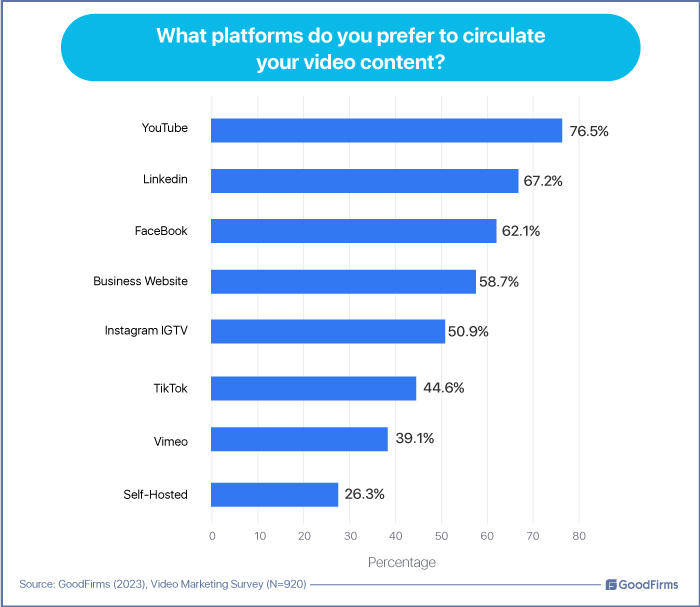
YouTube
76.5% of the survey participants prefer YouTube for circulating their marketing videos.
YouTube is the second-largest search engine in the world.(18) YouTube enables organizations to reach customers through a new medium, educates the audience, and aids in increasing interaction on digital and social channels. Marketers make videos, boost traffic, draw subscribers, and ultimately improve their revenue with the help of YouTube video marketing.
“Videos that thoroughly and usefully explain a concept in your industry can be great tools for marketing, outreach, and even internal training. They should be posted widely and often and hosted on a nice, accessible site like YouTube to allow for incidental traffic. Tagging your videos can be a useful way to organize them so that you can pull them back up as needed for future use," says Ben Michael, VP of Operations at Michael & Associates.
67.2% of the surveyees share their business videos on LinkedIn.
LinkedIn is a great visual platform for sharing educational videos. Videos are a fantastic method to convey information quickly and simply, and LinkedIn users value this. Posting videos on LinkedIn helps brands in connecting with the audience, establish credibility, and build their trust. Businesses are also spending their LinkedIn marketing budget on video content for LinkedIn advertising.
62.1% of the survey respondents circulate their marketing videos on Facebook.
Circulating videos on Facebook assists brands in increasing their brand visibility and helps in generating traffic to its website. It enables marketers to produce and share user-friendly content of high quality. Therefore, Facebook advertising help companies increase their site traffic, impressions, and click-through rates.
Business Website
58.7% of the survey participants post their marketing videos on their business websites.
Publishing videos on the business website helps brands in introducing their product/services and business goals, which in turn helps in building customer trust and brand recognition. Therefore, brands prefer circulating their marketing videos on their website to boost customer engagement, boost sales, boost SEO, and increase conversion rates and business growth.
Instagram IGTV
50.9% of the surveyed companies update their sales marketing videos on Instagram.
Instagram IGTV is a potent marketing tool for companies trying to increase their visibility and product exposure. Instagram is another great visual platform. Thus businesses use Instagram IGTV as a social media marketing tool to showcase their unique and attractive goods and services.
TikTok
44.6% of the surveyees share their business videos on TikTok.
Businesses create short video content to capture viewers' attention and highlight their brand's products/services. Brands are achieving success on TikTok by producing trend-driven organic content, using popular hashtags, and using TikTok influencers in advertising campaigns.
“For me, the best way to market my videos is by reaching out to influencers in the community who are already talking about the topic and inviting them to be a part of my project. I also like to make sure that every one of my videos has clear calls to action so that people know exactly how they can get involved after watching”, says Sarah Walters, Marketing Manager at The Whit Group.
Vimeo
39.1% of the surveyed marketers use Vimeo for sharing and publishing their brand’s product/service videos.
It's simple to generate appealing marketing videos with Vimeo's user-friendly interface from a PC or mobile. Vimeo allows quick share, embedding, and publishing of videos to the brand's website or on social media channels like Facebook, YouTube, and Twitter.
Self-hosting
26.3% of the survey respondents prefer self-hosting their marketing videos.
Businesses that adopt self-hosting do not have to worry about the terms of service of other platforms. Self-hosting also prevents advertisements from playing at the beginning of the videos. This gives viewers a clear interface devoid of any formatting or logos from third parties.
Top Challenges of Video Marketing
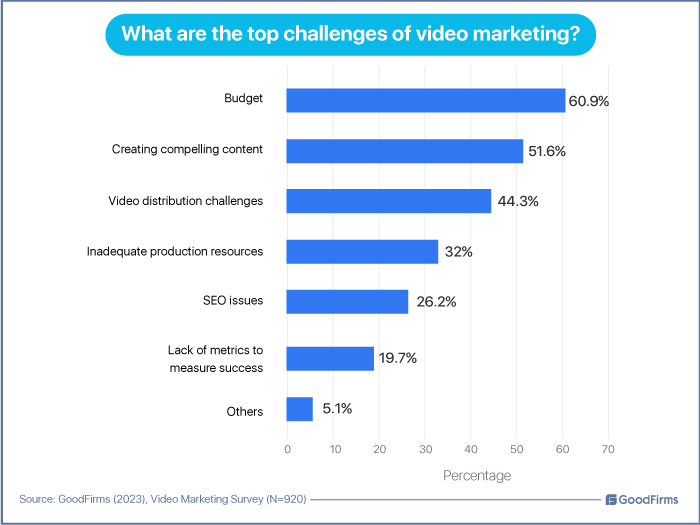
Budget
60.9% of the surveyed video marketers consider insufficient budget a major challenge to their video marketing strategy.
Businesses require a sufficient budget for creating a good sales marketing video. Video production costs are high as businesses are required to hire professional video designers and purchase special tools and editing software. Therefore, an inadequate budget is one of the challenges that brands face because it can lead to poor-quality video production, which is ineffective in attracting customers' attention or conveying the desired message.
According to Ann Martin, Director of Operations of CreditDonkey
“Because video content is more expensive and time-consuming to produce, we almost always try to promote our videos across as many of our channels as possible, including YouTube and every one of our social media platforms. We'll sometimes use this content in emails to potential customers and partners as well. We also tend to save and reuse our video content in a variety of contexts. They're great to link back to if the occasion comes up annually or when creating blog posts about related topics. Videos that really catch on will often have a long life, generating steady engagement for months or even years, so we do our best to keep coming back to content that has proven effective.”
Creating compelling content
51.6% of the surveyed participants said that creating compelling content for videos is one of the obstacles they deal with in video marketing.
One of the important variables that video search engines take into consideration when assessing content is engagement. Successful video content must be engaging and appealing to the audience. So that it can boost the conversion rate and sales rate of the brand’s products/services. Therefore, if a video is interesting, compelling, and engaging to customers, then only they will spend their time.
“In the age of social media, our collective attention spans have shortened dramatically. Pick one or two very key points and highlight those in the video. Keep it simple, keep it short, but most importantly, keep it entertaining and visually appealing”, says Josh Snead, CEO at Rainwalk Pet Insurance
Video distribution challenges
44.3% of the surveyed respondents said they face video distribution challenges in video marketing.
The majority of companies are unable to choose the right video-sharing platforms according to their video content, like YouTube or Vimeo. To increase the audience reach of marketing videos, brands are required to use the right video distribution tools and channels. These platforms offer broad reach, and high levels of engagement are the main reasons why marketers need to use this strategy.
Inadequate production resources
32% of the surveyees named the lack of video production resources as an obstacle.
Developing a great marketing video requires a high-quality camera, a studio, various editing tools and software, animation software, and a team of professionals. With a lack of production resources, many organizations are unable to prepare a desired marketing video for promoting their goods and services and fail to convey the message of the video.
SEO issues
26.2% of the surveyed companies face SEO-related issues in their video marketing strategy.
Increased page loading time, making transcripts available for search engines, ensuring video compatibility with HTML5, etc., are some of the SEO-related issues faced by companies in their video marketing efforts. Companies need SEO tools, marketing tools, and a variety of tools for researching customers and keywords for video scheduling and marketing video performance tracking.
Lack of metrics to measure success
19.7% of the surveyed marketers face the challenge of a lack of metrics for measuring the success of their marketing videos.
Selecting the right metrics is an essential component for the success of video marketing which is one of the obstacles that companies are dealing with. It is difficult to track video marketing metrics such as awareness rate, viewer demographics, play rate, watch time, average view duration, peak viewers, etc. A lack of metrics measurement strategy and tools prevents brands from measuring the success rate of their marketing videos. The right metrics and tracking applications help brands to know whether their content ideas for creating videos are working or not.
Others:
5.1% of the surveyees also face other challenges, such as a lack of effective video strategy, meeting deadlines, being unable to publish videos consistently, etc.
Videos are the Future of Marketing
Videos have been the preferred form of content delivery for consumers, but advertisers still continue to come up with innovative ways to reach out to both present and potential clients using this medium. Mark Zuckerberg said that the future of Facebook and Instagram lies in video, and this has proven to be true; social media videos are where the audience is. Videos help in creating a seamless and interactive experience for viewers that blends content and commerce. Video content helps businesses reach customers where they are. The top trends in video marketing that encourage customers to check out brands and buy their goods and services are always evolving, from short-form videos on TikTok and Instagram Reels to different live-streaming platforms and influencers unpacking goods.
Top trends in the future of video marketing:
- The strategy and optimization of content will be increasingly driven by data, and the rate of production of video content will only increase.
- Live streaming video will continue its phenomenal expansion, notably via esports.
- The key to increasing the sale of a company's product is partnering with social media influencers that effectively use or showcase the product in the form of short videos on TikTok, Instagram, or YouTube.
- The capacity to optimize brand, creator and influencer partnerships will be made possible by AI, enabling brands to maximize return on investment and enable content creators to earn money from their work.
- For marketers, videos will increasingly play a key role in their marketing strategies.
- As influencers' videos are more popular among the audience than any brand's content, businesses will need to use influencer marketing.
According to Ahmet Durmusoglu, Co-Founder of ContentGo
“In terms of future advancements related to video production, I think we’ll see a lot more tools and technologies that will help make the process easier and faster for creators. For example, automated systems for producing video content in bulk, AI-driven software for editing videos and motion graphics, etc., are all likely to become more prominent. Moreover, the role of virtual reality (VR) is also growing exponentially - from creating immersive experiences to enhancing storytelling capabilities - VR has huge potential when it comes to video production.”
Key Findings
- Videos help in creating a seamless and interactive experience for viewers that blends content and commerce.
- According to the GoodFirms survey, 73.9% of marketers are using video as a crucial component of their sales and marketing strategy.
- In the future, the usage of AR/VR and AI will help to improve both the brand's and customer's experiences with video marketing.
- 81.2% of the surveyed marketers say increasing online engagement with the audience is the topmost objective of video marketing strategy
- 74.6% of the surveyed respondents believe increasing their brand awareness is the top objective of effective video marketing
- 43.5% of the surveyed video marketers prefer short video ads or GIFS to promote their brand and its goods/services.
- 80.6% of the surveyed video marketers create marketing videos to post on social media channels.
- 73% of the surveyed participants prepare marketing videos for the purpose of content strategy.
- 70.5% of the surveyed participants suggest a good video script as a key element for a successful marketing video.
- 65.2% of the surveyees said understanding the target audience stands as the prime element to creating a successful video
- 75.3% of the surveyed video marketers use technology to create content for marketing videos.
- 68.3% of the surveyed participants use video editing, adding effects, and merging software while creating their marketing videos.
- 76.5% of the survey participants prefer YouTube for circulating their marketing videos.
- 60.9% of the surveyed video marketers consider insufficient budget a major challenge to their video marketing strategy.
- 51.6% of the surveyed participants said that creating compelling content for videos is one of the obstacles they deal with in video marketing.
Conclusion
Video marketing is becoming an essential strategy for brands to connect and engage with their target audience. The market for video marketing is expanding with the emergence of social media platforms and video-sharing websites. Businesses are using video marketing as one of their important strategies to raise brand awareness, improve SEO, customer engagement and retention, increase conversion rate and boost sales.
One of the biggest benefits of video marketing is that customers remember it much easier.
The future scope of video marketing looks bright as video marketing is an integral part of the marketing mix. The latest tools and technologies, such as the internet of things, artificial intelligence, 5G fast internet connection, augmented reality, and virtual reality, will assist businesses to grab new opportunities to develop more engaging content for viewers.
With the use of advanced analytics tools, Companies can monitor and measure the success of their video marketing campaigns and engagement metrics and make data-driven decisions to optimize their video content.
We sincerely thank our Research Partners for their valuable insights.
References
- https://www.wyzowl.com/video-marketing-statistics/
- https://www.statista.com/statistics/1254810/top-video-content-type-by-global-reach/
- https://www.cisco.com/c/dam/m/en_us/solutions/service-provider/vni-forecast-highlights/pdf/Global_Device_Growth_Traffic_Profiles.pdf
- https://wyzowl.s3.eu-west-2.amazonaws.com/pdfs/Wyzowl-Video-Survey-2021.pdf
- https://www.statista.com/statistics/611750/millennial-time-spent-with-online-video/
- https://www.statista.com/statistics/256272/digital-video-advertising-spending-in-the-us/
- https://www.youtube.com/watch?v=JHPCQXT8r4w
- https://revery.is/stories/moving-mountains
- https://www.youtube.com/watch?v=Fd1fwp0j3Eo
- https://www.youtube.com/watch?v=CiEcW_YEs3E&feature=youtu.be
- https://www.oralb.co.uk/en-gb/product-collections/genius-x
- https://www.youtube.com/watch?v=CqX4W3Rz8iw
- https://www.wyzowl.com/amazing-video-marketing-statistics/#
- https://www.youtube.com/watch?v=Sknnd-pkQ8A
- https://www.statista.com/statistics/961139/average-number-vloggers-adults-watch-each-week-usa-age/
- https://www.forrester.com/blogs/09-01-08-the_easiest_way_to_a_first_page_ranking_on_google/
- https://think.storage.googleapis.com/images/micromoments-guide-to-winning-shift-to-mobile-download.pdf
- https://www.globalreach.com/global-reach-media/blog/2020/01/28/the-2nd-largest-search-engine-on-the-internet
Survey Participant Demographics:
Firmographics:
The queried video marketers, business owners, professionals, or executives comprise 33.5% of the IT sector, 18.6% provide professional services, 9.3% include the telecommunications sector, 6.2% of the educational sector, and many more.
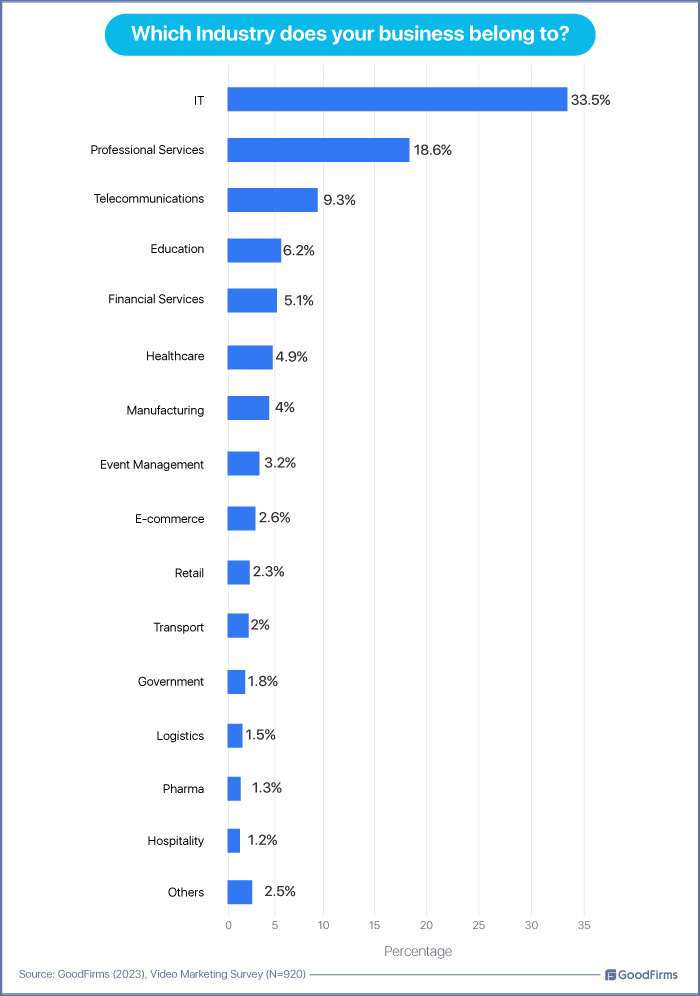
According to the GoodFirms survey, 43.6% of the participants have small businesses, 35.9% own medium-scale businesses, 12.4% of the surveyees have large-scale organizations, and 8.1% have started startup businesses.
